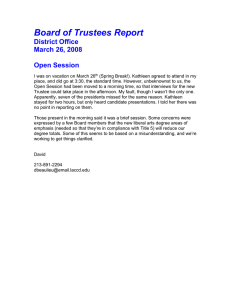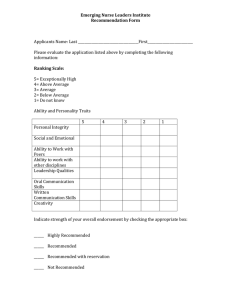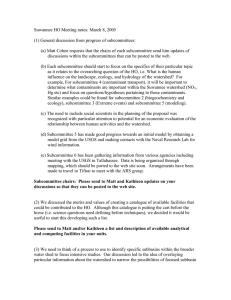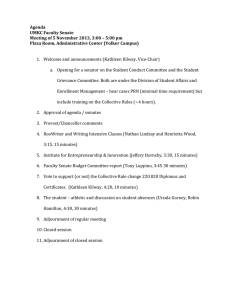Meeting notes March 22
advertisement
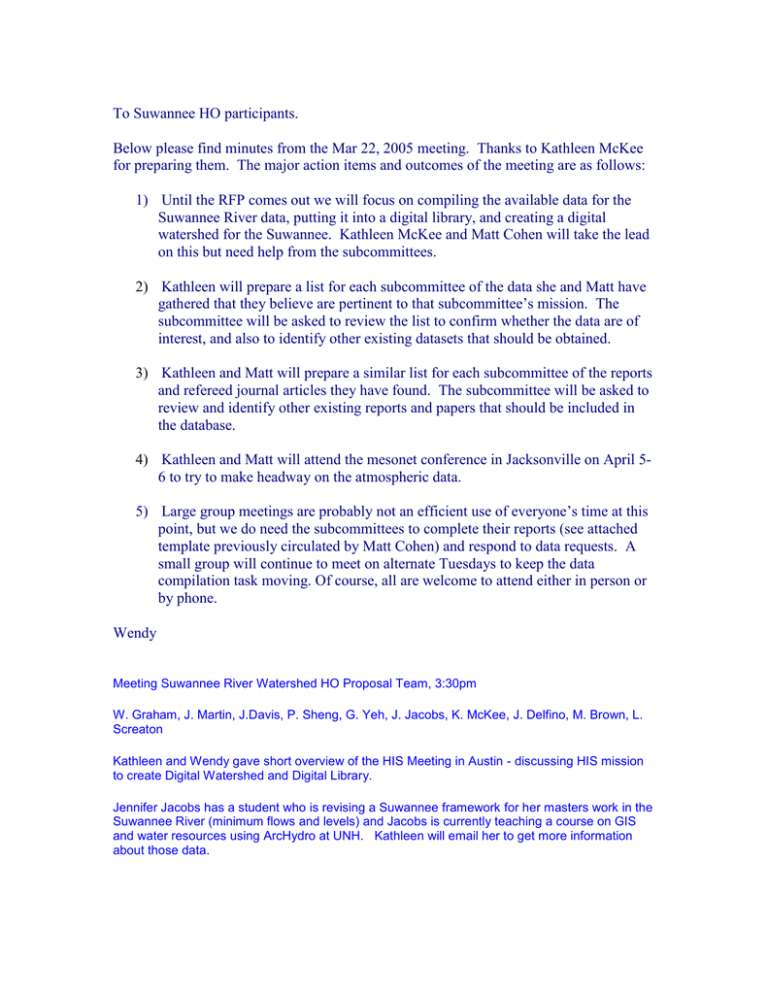
To Suwannee HO participants. Below please find minutes from the Mar 22, 2005 meeting. Thanks to Kathleen McKee for preparing them. The major action items and outcomes of the meeting are as follows: 1) Until the RFP comes out we will focus on compiling the available data for the Suwannee River data, putting it into a digital library, and creating a digital watershed for the Suwannee. Kathleen McKee and Matt Cohen will take the lead on this but need help from the subcommittees. 2) Kathleen will prepare a list for each subcommittee of the data she and Matt have gathered that they believe are pertinent to that subcommittee’s mission. The subcommittee will be asked to review the list to confirm whether the data are of interest, and also to identify other existing datasets that should be obtained. 3) Kathleen and Matt will prepare a similar list for each subcommittee of the reports and refereed journal articles they have found. The subcommittee will be asked to review and identify other existing reports and papers that should be included in the database. 4) Kathleen and Matt will attend the mesonet conference in Jacksonville on April 56 to try to make headway on the atmospheric data. 5) Large group meetings are probably not an efficient use of everyone’s time at this point, but we do need the subcommittees to complete their reports (see attached template previously circulated by Matt Cohen) and respond to data requests. A small group will continue to meet on alternate Tuesdays to keep the data compilation task moving. Of course, all are welcome to attend either in person or by phone. Wendy Meeting Suwannee River Watershed HO Proposal Team, 3:30pm W. Graham, J. Martin, J.Davis, P. Sheng, G. Yeh, J. Jacobs, K. McKee, J. Delfino, M. Brown, L. Screaton Kathleen and Wendy gave short overview of the HIS Meeting in Austin - discussing HIS mission to create Digital Watershed and Digital Library. Jennifer Jacobs has a student who is revising a Suwannee framework for her masters work in the Suwannee River (minimum flows and levels) and Jacobs is currently teaching a course on GIS and water resources using ArcHydro at UNH. Kathleen will email her to get more information about those data. April 4-6 weather folks J. Lanier, P. Welsh and P. Ruscher are going to be at the Florida mesonet conference on April 5-6 in Jacksonville and Rusher hopes "we can get our heads together at that time" to begin to offer more help in the area of weather data cataloguing." So Kathleen hopes to go meet them at that time. Rick Copeland has offered his help along with Tom Greenhalgh to assist with giving us info about new mapping efforts at FL Geol Survey. Also says he has a staff person assisting in the building of a database for the types of data we are asking for. March 30 there is a Springs meeting (J. Martin, T. Greenhalgh and others) at UF. Modelers (Sheng, Yeh) would like 3D grid of estuary; hoping to get from Sam Upchurch (he does MODFLOW for SRWMD). Modelers have a DEM. Kathleen will send them Bathymetry of estuary/lower Suwannee and a NED (national elevation dataset) which is supposed to be higher resolution than DEM. Another RFP "Cyberinfrastructure for Environmental Observatories" will be coming from NSF June1 - $8M total - $250,000/yr for 3 yrs for each grant. Money from NEON< Ocean Observatory, CLEANER, and most from CISE - no Earth Sci money. " Sheng shares what 'cyberinfrastructure' is: distributed compting, modeling, grid computing for sharing across regions, high speed networking. Coastal ocean modeling is doing this. Virtualization middleware, double-E approach; Can leverage what they are doing here at UF in a cyberinfrastructure proposal. At UF, they have $1.3M to set up high-speed network; Now 2nd phase campus research grid. Each dept giving 100K - for switches, clusters, computers etc. Will have more than 1000 cpus. Eventually link up with Florida and national Lamda rail. Kathleen started to work on ArcHydro to get a basic hydrologic system set up to include hydrography, basins, elevation, topography, soils, land cover, geology etc. Available time series data is still not documented. We have documentation on USGS and SRWMD water stations - still need to find out about GA and more detail about USGS after we get access to the NWIS system in Tallahassee. Still need to document available weather data. This is higher priority to building ArcHydro system for now. Kathleen and Matt working on a large bibliography (reports, journal articles etc) that will be indexed by title, year, author. Only title and authors will be searchable, not "keywords" or abstracts. Kathleen will send specific list of available data to each subcommittee as it pertains to that subcommittee to get a response if that data is adequate or if something is obviously missing. We expect that there will be more input from subcommittees as to availability of time-series and project data. J. Davis suggested that data be searched for by looking at journal articles to find project data. We did this for SRWMD projects by searching their publications. Can do same for USGS pubs and others? Jennifer Jacobs working on a 10 year daily reference ET model based on Land Use, GOES solar radiation... to get gridded data. Using actual temp, vapor pressure, wind speed, solar rad, etc. 2 KM grid. North American Regional Reanalysis (NARR) model developed and maintained by the National Centers for Environmental Prediction (NCEP) NARR data was disussed. http://wwwt.emc.ncep.noaa.gov/mmb/rreanl/ . NARR is a continental scale model (32km grid cells); output provides information on the energy and water fluxes important for closing the water and energy budgets.
